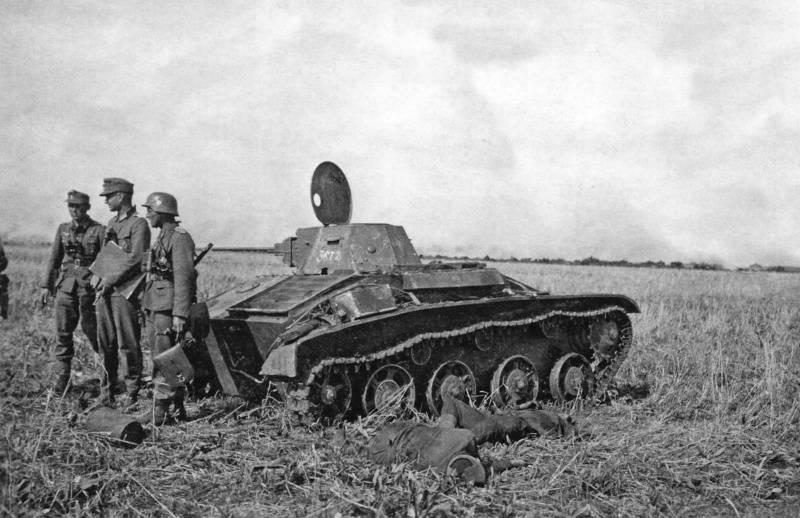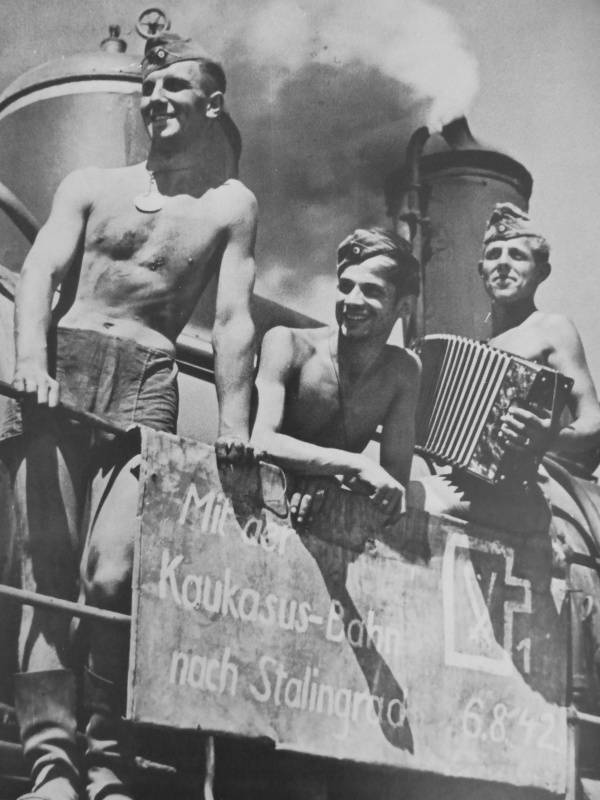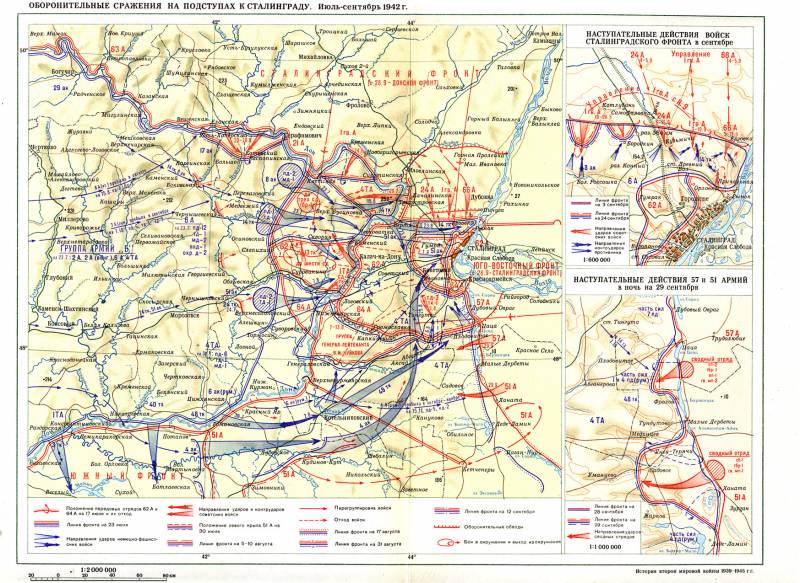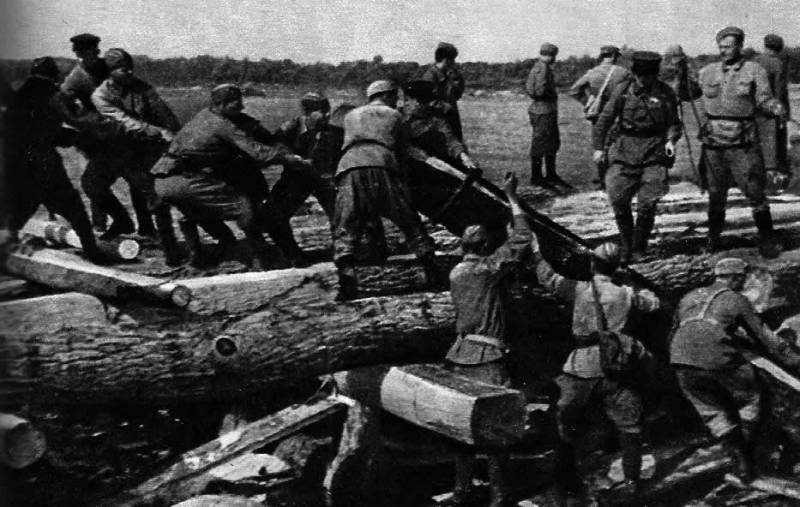1942 year. "The operation in the south develops without stopping"
In the diary Halder at this time is increasingly referred to Stalingrad. July 16: "According to quite reliable information, one should expect that the enemy uses all the forces and means to hold Stalingrad ... Meeting with Gehlen and Heusinger:" Discussion of the plan for the upcoming battle at Stalingrad "." 18 July: “According to the agents, Stalin uses everything to defend Stalingrad, to send his troops over the Don and to keep this line. ... On the report from the Führer today ... "the highest order" was given, requiring the Don to be forced on a wide front (south, east of the mouth of the Donets) and the battle for Stalingrad began. " July 20: "The 6-I army successfully moves to the southeast." July 21: “The troops of Paulus (6-I army) very quickly and energetically move forward to Stalingrad, where the enemy is trying to transfer its troops by rail from the north-west and by road. The change of troops at the front along the Don and the pulling up of forces are proceeding well. ” July 22: "The promotion of the 6 Army is ensured, guarding of the Don is successfully organized."

Germans next to the wrecked Soviet a tank T-60 near Stalingrad
When enemy intentions became completely clear to the Soviet command, it developed plans for the defense of Stalingrad. The enemy sought to defeat the armies of the Southern Front, and with access to the Volga and the capture of Stalingrad, cut the Soviet strategic front into two isolated parts, sever the communications that linked the central regions of the USSR to the Caucasus. With the solution of this task, according to the supreme German command, the final goal of the war was approaching: the defeat of the Red Army and the conquest of Soviet Russia. “In those days, the Soviet Union was experiencing a severe crisis,” wrote Hans Dörr. “Apparently, the Russians, although they made a systematic retreat to the Don, under pressure from German units, were forced to retreat to the Volga and the Caucasus before the scheduled time; in some areas, their retreat turned into an escape. This was reflected in the significant from different points of view order of Stalin, issued at the end of July ”(G. Dörr. Hike to Stalingrad. Operational review).
Thus, the situation on the southern flank of the Soviet-German front was extremely unfavorable for the USSR. The Wehrmacht, having the initiative, a great combat experience, having superiority in forces, especially in tanks and aircraft, rushed to the east. Soviet troops had to retreat, leaving the richest areas of the Don to the enemy.
It was necessary to stop the enemy, give him battle, grind the German troops and create the prerequisites for a breakthrough on the front. The commanders of the Stalingrad front Marshal of the Soviet Union S.K. Tymoshenko, and from July 23 - Lieutenant-General V.N. Gordov carried out the directive of the Stake about urgent measures to protect Stalingrad. Commander-in-chief S. K. Tymoshenko ordered troops of the front to hold the area of Stalingrad and prepare forces for a counterstrike in the western and south-western directions.
As previously noted, the original command of the SF had limited means and power to accomplish this task. The front included three reserve armies (63, 62 and 64) and two armies of the former Southwestern Front (21 and 8). In the second half of July, the 28-I, 38-I and 57-I armies entered the Stalingrad front. However, a large number of compounds should not be misleading. The reserve armies were not all fully staffed at the time of the redeployment from the rear of the country to the front (the 62 Army, for example, had a shortage of men and weapons), the new formations were not properly knit together and, as a rule, did not have combat experience. There was an acute shortage of anti-tank and anti-aircraft artillery. Many divisions lacked ammunition and vehicles. In addition, after advancing from the depths, Soviet troops had to take up positions on the ground, where usually there were no defensive lines prepared in advance. The troops because of the long way stretched the time of arrival in the area of Stalingrad and the concentration on the lines of defense. On the march, they were hit by German aviation and suffered casualties.
As for the armies of the former South-Western and Southern fronts, they were drained of blood in heavy battles during the retreat to Stalingrad, and the remnants of their units suffered heavy losses in manpower and had little military equipment. Therefore, a significant part of them was immediately relegated to the front rear to form new compounds based on them. The 13, 22, and 23 tank corps, which had been withdrawn from Kharkov, were placed at the disposal of the commander of the Stalingrad Front, were taken to the rear for replenishment by men and equipment. Of the remnants of nine rifle divisions of the 38 Army, the control of four divisions was relegated to the rear to create on their basis new units. The management of the 57 Army in the second half of July was withdrawn to the region of Stalingrad. The difficult situation was with aviation. 8-I air army of General T. T. Khryukin was equipped with airplanes only 50%. The 8 Air Force's fleet on the 70-75% consisted of obsolete vehicles. New aircraft such as the Yak-1, Pe-2 and IL-2 were still few. The conditions were bad: there were no prepared airports, fuel depots, ammunition, various equipment and materials.
At the same time, the Supreme Command headquarters continued to strengthen the Stalingrad sector. The 8 aviation regiments (10 aircraft) were sent to reinforce the 200 Air Force, which suffered great losses. By 22 July, the 18-th and 131-rifle divisions, the 28-th tank corps, as well as other tank and artillery units and units were sent to the commander of the Stalingrad front. A few days later (July 26-27) 126-I, 204-I, 205-I, 321-I, 399-I and 422-I divisions began to arrive in the region of Stalingrad from the Far East. Some of them went to the formation of new armies, others on the move entered into heavy battles that unfolded at the distant approaches to Stalingrad. To combat the enemy landings in the Stalingrad region formed 80 fighter battalions, which numbered 11 thousand. People.
Thus, the Stalingrad front gradually increased its strength. But the struggle began when the Federation Council had limited opportunities to stop the enemy and the situation was critical. The defense zone from Pavlovsk to Verkhne-Kurmoyarskaya, where resistance was to be organized, was more than 500 km. By the beginning of the battles, not all its sectors had troops, and the front command had to take emergency measures in order to put barriers in the most dangerous places and to keep the advancing German troops.
The beginning of the battle
Six rifle divisions, three tank brigades and two separate tank battalions of the 63 Army under the command of V. I. Kuznetsov turned around on the 250-kilometer front from Pavlovsk to Serafimovich. Intelligence was advanced to the right bank of the Don, the main forces were on the left bank. Kuznetsov’s army was supposed to prevent the enemy from breaking through beyond the Don, keeping the railroad that led to Stalingrad from the north-west. The 21 Army under the command of A. I. Danilov, by the forces of three divisions, occupied the defense of an approximately 60-kilometer section from Serafimovich to Kletskaya. The army was located on the left bank of the Don.
Further, the front turned south. The 90-kilometer section from Kletskaya to Surovikino was defended by the V. Y. Kolpakchi 62 Army, which included six rifle divisions, four regiments of cadets of military schools, one such brigade, six separate tank battalions. Kolpakchi paid most attention to his left flank, where he passed the shortest path to Stalingrad from the west. The 64 Army under the command of V. N. Gordov, consisting of four rifle divisions (only two divisions arrived in the Stalingrad region by 22 July), two rifle brigades, four regiments of military school cadets and one tank brigade deployed for the 120-kilometer sector Surovikino to Verkhne-Kurmoyarskaya. The left-flank formations of the army took up defensive positions on the left bank of the Don. The forward detachments of the 62 and 64 armies were advanced to the line of the Chir and Zimla rivers. 57-I army made up the reserve of the front and was on the re-formation north of Stalingrad. At the direction of Bet, the administration of the 38 Army began the formation of the 1 Army, and the administration of the 28 Army began the formation of the 4 Army.
By July 22 only the B2 and 63 armies had to advance to the defensive line, and only 64 and 214 I divisions of the 229 army arrived and occupied the defense. The commanders of the combined-arms armies built their troops in two echelons with the allocation of strong reserves. Thus, 63, 127, 1 and 153 infantry divisions with a width of defense bands for each division from 197 to 40 km were advanced to the first echelon of the 102 army. In the second echelon (30 km from the front edge of the defense) was the 203-I infantry division. In 100 km from the front line there was an army reserve: the 14-I Guards Rifle Division, two tank battalions and one regiment of anti-tank artillery. In the 62 Army, the first echelon was the 192-I, 33-I Guards, 181-I, 147-I infantry divisions (width of the defense lines of these divisions from 14 to 42 km), 196-I division occupied the defense on the left flank of the army on the turn of Surovikino - Nizhne-Solonovsky. The 184 Division was in the second echelon (30 km from the front edge of the main line). The reserves of the army were located behind its left flank. Thus, the combat formations of the Soviet divisions were greatly stretched.
Construction of the crossing over the Don. July 1942
The forward detachments of the 62 Army under the command of Major General V.Ya. Kolpakchi were the first to encounter the enemy. Kolpakchi army from 11 to 17 July made a march to its designated area and turned on the front from Kletskaya to Surovikino. The appropriate units immediately began defensive work, organizing a system of fire, observation, conducted intelligence in front of their leading edge. The forward detachments of the army moved to the line of the rivers Tsutskan, Chir, Zimla.
16 July 1942, the advanced units of the enemy came to the river. Chir and entered into combat contact with parts of the 62-th army. “In 20: 00, four German tanks secretly approached the Golden Farm and opened fire on the detachment. The first battle of the Battle of Stalingrad lasted 20-30 minutes. The tank crews of the 645 tank battalion stated that the 2 of the German tank had been destroyed, the 1 anti-tank gun and another 1 tank had been destroyed. Apparently, the Germans did not expect to collide with two tank companies at once and only four cars were sent ahead. Detachment losses were one T-34 burned out and two T-34s destroyed. The first battle of the bloody months-long battle was not marked by a death — a loss of two tank companies made 11 people wounded. Dragging along two wrecked tanks, the detachment came back "(A. V. Isaev." Stalingrad. There is no land for us beyond the Volga "). Thus, at the distant approaches to Stalingrad, in the great bend of the Don, a great battle began. The Germans immediately met with organized resistance from the Soviet troops. The enemy did not expect this, although he did not attach much importance to this.
On July 17, at the border of the Chir and Tsimla rivers, the advance detachments of the 62nd and 64th armies of the Northern Fleet engaged in battle with the vanguards of the 6th German army. Interacting with the aircraft of the 8th Air Army, they put up stubborn resistance to the enemy. So the advance detachment of the 192nd Infantry Division - the 676th Infantry Regiment, the 1st Division of the 293rd Artillery Regiment, the 644th Tank Battalion - on July 17 at the farm Pronin came into contact with the Germans. "Holding back the enemy, the regiment with heavy battles in a semicircle retreated to the main defense zone of the division." It is worth noting that the 192nd Infantry Division was a fully operational formation. Its core was the Black Sea sailors - the 102nd cadet-naval brigade, which in the spring of 1942 was withdrawn from combat in the Taganrog direction. At the formation in the Stalingrad region, the division included cadets of military infantry schools: Nalchiksky, Uryupinsky. 3rd Ordzhonikidze, 3rd Grozny, Zhytomyr, the 192nd division had three rifle regiments (676th, 427th and 753rd), artillery regiment (298th), a separate anti-tank fighter division (417th ), combat engineer battalion, medical battalion, reconnaissance, separate battalion of communications. The division commander, Colonel A.S. Zakharchenko, a participant in the First World and Civil Wars, was a man with great combat experience and knowledge. He met the beginning of the war, commanding the 25th Chapaev division. Together with border guards and sailors of the Danube flotilla For almost a month the division kept the Soviet border in a hundred-kilometer strip along the Danube.
A similar picture was on other sites. The forward detachment of the 33 Guards Rifle Division of the 62 Army repulsed three attacks of the German troops. Some details about the battles on this day are reported in the “Short Essay of the Combat Path of the 62 Army”: “The 88 (Infantry) Regiment of the 33 Guards (Infantry Division) on July 21 fought with the enemy at the turn of 5 kilometers west of Petrovka. During the day, the guards repelled three fierce attacks from the enemy, destroying infantry battalions and 20 tanks to the battalion. The next morning, the enemy threw up to two infantry regiments to this unit. The battle resumed with a new force. Having rolled away under the crushing blow of the Guards, the Germans repeated the attack in the afternoon. And our warriors repelled it, inflicting great losses on the Nazis. ”
As a result, the German advance rate fell from 30 km to 12-15 km per day. To break the resistance of the Soviet troops, the Germans had to enter into the battle part of the main forces, deploy 5 divisions and spend 5 days to fight with our forward troops. This allowed our troops to gain time for pulling up troops from the reserve and deploying them on the lines of defense in order to restore the combat capability of units and formations that had previously fought hard and retreated under the onslaught of the enemy. In the end, it took six to seven days for the German army to break the resistance of the advanced Soviet troops and get out, covering the distance of 70 km, to the main line of defense on the distant approaches to Stalingrad.
As the 6 of the German army advanced towards Stalingrad, its left flank strongly stretched along the right bank of the Don to the northeast front. In addition, the unexpectedly stubborn resistance of the Soviet forces forced the German command to strengthen the forces in the Stalingrad sector. 17 July 1942 was transferred from the reserve of the main command to the 6 army and transferred the 14 tank corps (16 tank and 60 motorized divisions). Two days later, the 6 Army returned the 4 Army Corps (51, 44 and 71 infantry divisions) from the 297 Tank Army. From the OKH reserve, the 6-i guard division arrived at the disposal of the commander of the 403 of the German army. At the same time, the 6th Infantry Division operating on the left flank of the 75 Army was transferred to the neighboring left 2 Hungarian Army. As a result of regrouping, 6 had 22 divisions (including 18 tank and 1 motorized divisions) by the end of 2 in July, and along with reinforcement units, about 250 thousand people, 7500 guns and mortars, 740 tanks. She was supported by powerful aviation forces.
A few days later, two more corps began to be deployed from Army Group “A” —the 24 tank and 11 army corps, as well as the Italian 8 division consisting of seven infantry divisions, one infantry and one cavalry brigade. The Italian army was to occupy the right bank of the Don in the area from Pavlovsk to Veshenskaya, in order to free part of the troops of the 6 Army for the offensive on Stalingrad. In addition, the 3 Rumanian army was advanced to the Stalingrad sector. The ground forces were supported by the main forces of the 4 air fleet and the 8 air corps. As a result, the Germans concentrated on the Stalingrad direction around 30 divisions and 1200 aircraft. This allowed the Germans to create supremacy over the troops of the 62 and 64 armies in manpower and equipment by more than 2 times in the areas of strikes. In aviation, superiority was 3-4 times.
The Soviet command took extraordinary measures to strengthen aviation in the Stalingrad sector. To strengthen the 8 Air Force (had 337 serviceable aircraft) sent (from July 20 to August 17) 23 aviation regiment - about 450 aircraft. In addition, five long-range aviation divisions were deployed to airfields located near Stalingrad. By September 4, the 16 Air Force under the command of General P. S. Stepanov was formed as part of the Federation Council (since the end of September, the army was headed by General S. I. Rudenko).

Soldiers of the Wehrmacht 94 Infantry Division posing for trophy Soviet locomotive. On the shield there is a division emblem with the inscription: “By the Caucasian railway to Stalingrad. 6.8.42
To be continued ...


Information